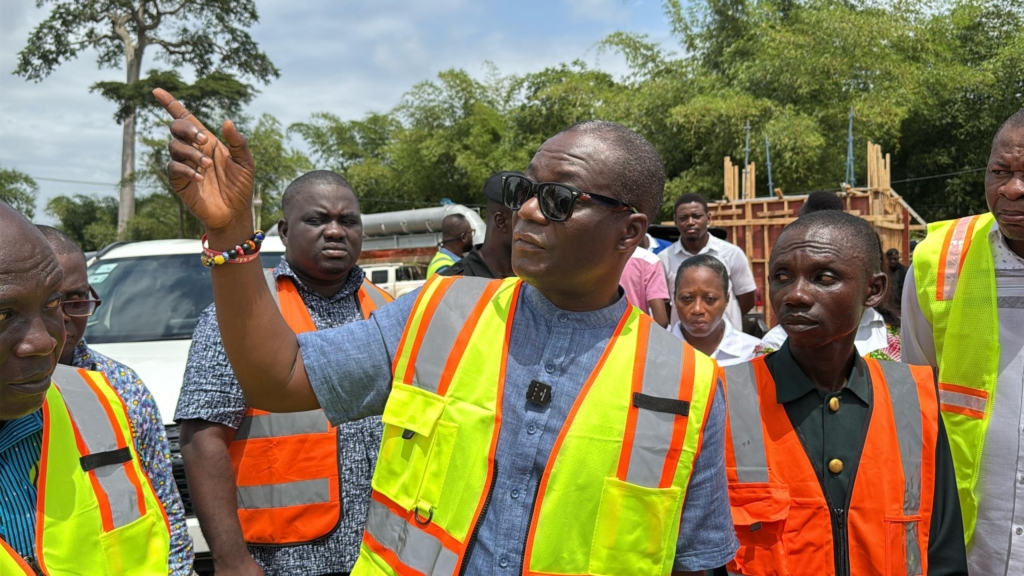The Western Regional Minister, Mr Joseph Nelson, has issued a strong warning against the growing encroachment on Ghana Water Company Limited’s (GWCL) lands at the Daboase water treatment site in the Wassa East District, describing the development as illegal and detrimental to the region’s water security.
During a familiarisation visit to the site, the Minister directed GWCL to urgently demarcate the buffer zones surrounding the facility to halt further unauthorised human activities threatening the critical water resource.
“This is a major national investment. Encroachment on this land must stop immediately. The chiefs who sold land within the buffer zone claim ignorance, stating they didn’t know it was a restricted area. To prevent further encroachment, I suggest installing signposts to clearly mark the buffer zone as a no-go area. If ignored, the law should take its course,” the Minister warned.
He urged the District Chief Executive to engage the local chiefs and ensure that no further activity occurs within the designated restricted zones.
The move seeks to protect the ongoing €70 million water expansion project at Daboase, being undertaken by Austrian firm Strabag, which aims to supply 22 million gallons of water daily to Sekondi-Takoradi and its surrounding communities.

Mr Nelson expressed concern that, despite visible signs of illegal development, landowners in the area have distanced themselves from the encroachment, claiming no knowledge of how such activities commenced.
“The development of this project won’t be allowed to suffer, despite the clearing already done. Their actions are illegal and threaten the water supply to the metropolis and neighbouring communities,” he stressed.
The Daboase facility, originally built in the late 1960s with a six-million-gallon daily capacity, currently struggles alongside the Inchaban plant (four million gallons per day) to meet rising demand. The new project is expected to close that supply gap.
According to Mr Vlad Falup, Project Manager at Strabag Engineering, “All main structures are complete. We’re currently working on the high-lift pumping station, which houses the pumps that will transport water to Inchaban and other pumping stations. The mechanical equipment is in place, and though the tanks are underground with structures above, we are confident we will finish by 7 November 2025.”

However, GWCL officials have raised red flags over the rapid rate of encroachment. Gideon Asare Annor, Western Regional Manager in charge of production at GWCL, warned that the environmental damage could jeopardise the entire investment.
“As you can see, the buffer zone has been completely encroached upon. This means the river will likely dry up faster than usual during the dry season, rendering our 22-million-gallon-per-day treatment plant idle, which would be unfortunate,” he noted.
“The encroachment is evident, especially since the area is prone to erosion. Ideally, the buffer zone should start further up to prevent runoff and protect the water source,” he added.
The situation is further exacerbated by climate change, illegal mining, and other human activities that have significantly increased water turbidity. As a result, GWCL’s water production from the Daboase plant has dropped from six million gallons per day to just over 16,000 gallons per day.
With demand for clean water in Sekondi-Takoradi and its environs steadily rising, the Regional Minister’s warning and the call for immediate action have brought fresh urgency to the need for sustainable protection of Ghana’s water sources.
DISCLAIMER: The Views, Comments, Opinions, Contributions and Statements made by Readers and Contributors on this platform do not necessarily represent the views or policy of Multimedia Group Limited.
DISCLAIMER: The Views, Comments, Opinions, Contributions and Statements made by Readers and Contributors on this platform do not necessarily represent the views or policy of Multimedia Group Limited.
